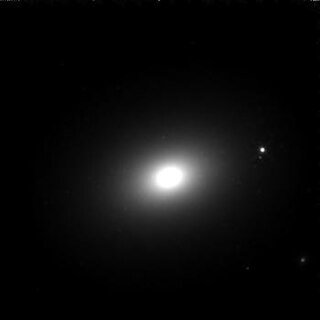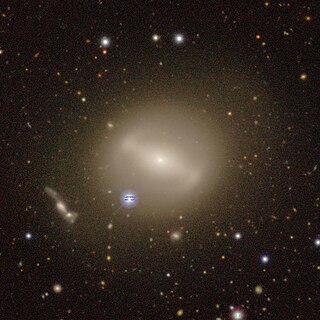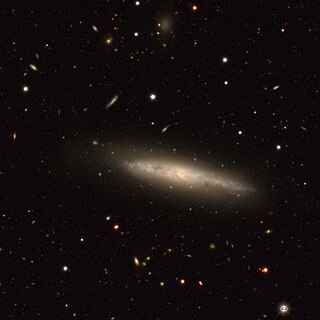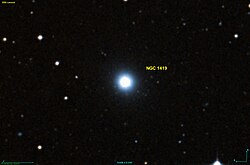
The Virgo Cluster is a large cluster of galaxies whose center is 53.8 ± 0.3 Mly away in the constellation Virgo. Comprising approximately 1,300 member galaxies, the cluster forms the heart of the larger Virgo Supercluster, of which the Local Group is a member. The Local Group actually experiences the mass of the Virgo Supercluster as the Virgocentric flow. It is estimated that the Virgo Cluster's mass is 1.2×1015M☉ out to 8 degrees of the cluster's center or a radius of about 2.2 Mpc.

NGC 1316 is a lenticular galaxy about 60 million light-years away in the constellation Fornax. It is a radio galaxy and at 1400 MHz is the fourth-brightest radio source in the sky.

NGC 1427 is a low-luminosity elliptical galaxy located approximately 71 million light-years away from Earth. It was discovered by John Frederick William Herschel on November 28, 1837. It is a member of the Fornax Cluster. The galaxy has a stellar mass of 7.9 × 1010M☉, and a total mass of 9.4 × 1010M☉. However, the mass of the dark matter halo surrounding the galaxy is around 4.3 × 1012M☉.

NGC 7007 is a lenticular galaxy with a small bar, around 100 million light-years away from Earth in the constellation Indus. It was discovered by astronomer John Herschel on July 8, 1834. The galaxy is a type 2 seyfert galaxy, and is host to a supermassive black hole with an estimated mass of 4.9 × 107M☉.

NGC 7014 is an elliptical galaxy located about 210 million light-years away from Earth in the constellation Indus. NGC 7014 was discovered by English astronomer John Herschel on October 2, 1834. A population of around 1,634 known globular clusters surround the galaxy, and it is also host to a supermassive black hole with an estimated mass of 2.6 × 109M☉. NGC 7014 is also classified as a type 1 seyfert galaxy.

NGC 7015 is a spiral galaxy located about 203 million light-years away from Earth in the constellation Equuleus. NGC 7015's calculated velocity is 4,881 km/s (3,033 mi/s). NGC 7015 was discovered by French astronomer Édouard Stephan on September 29, 1878.

NGC 1436 is a barred spiral galaxy with LINER activity approximately 58 million light-years away from Earth in the constellation of Eridanus. NGC 1436 is a flocculent spiral galaxy lying almost face-on to the Earth. It is a member of the Fornax I cluster.

NGC 708 is an elliptical galaxy located 240 million light-years away in the constellation Andromeda and was discovered by astronomer William Herschel on September 21, 1786. It is classified as a cD galaxy and is the brightest member of Abell 262. NGC 708 is a weak FR I radio galaxy and is also classified as a type 2 Seyfert galaxy.

NGC 753 is a spiral galaxy located 220 million light-years away in the constellation Andromeda. The galaxy was discovered by astronomer by Heinrich d'Arrest on September 16, 1865 and is a member of Abell 262.

NGC 1381 is a lenticular galaxy located in the constellation Fornax. It is located at a distance of about 60 million light years from Earth, which, given its apparent dimensions, means that NGC 1381 is about 55,000 light years across. It is a member of the Fornax Cluster. NGC 1381 appears edge-on and features a thin disk with high surface brightness and a boxy bulge. Both the box-shaped bulge and the kinematics of the central area of the galaxy suggest that NGC 1381 has a bar.

NGC 4318 is a small lenticular galaxy located about 72 million light-years away in the constellation Virgo. It was discovered by astronomer John Herschel on January 18, 1828. NGC 4318 is a member of the Virgo W′ group, a group of galaxies in the background of the Virgo Cluster that is centered on the giant elliptical galaxy NGC 4365.

NGC 1460 is a barred lenticular galaxy with a peanut-shaped bar approximately 65 million light-years away from Earth in the constellation of Eridanus. It was discovered by astronomer John Herschel on November 28, 1837. It is a member of the Fornax cluster.

NGC 1369 is a barred lenticular galaxy located 59 million light years away in constellation of Eridanus. The galaxy was discovered by astronomer Julius Schmidt on January 19, 1865, and is a member of the Fornax Cluster. NGC 1369 is a host to a supermassive black hole with an estimated mass of 1.8 million solar masses.

NGC 1484 is a barred spiral galaxy approximately 50 million light-years away from Earth in the constellation of Fornax. It was discovered by astronomer John Herschel on November 28, 1837. NGC 1484 is a member of the Fornax cluster.

NGC 1428 is a peculiar galaxy of an uncertain morphology; either an elliptical or lenticular galaxy located approximately 65 million light-years away from Earth.

NGC 4324 is a lenticular galaxy located about 85 million light-years away in the constellation Virgo. It was discovered by astronomer Heinrich d'Arrest on March 4, 1862. NGC 4324 has a stellar mass of 5.62 × 1010M☉, and a baryonic mass of 5.88 × 1010M☉. The galaxy's total mass is around 5.25 × 1011M☉. NGC 4324 is notable for having a ring of star formation surrounding its nucleus. It was considered a member of the Virgo II Groups until 1999, when its distance was recalculated and it was placed in the Virgo W Group.

NGC 4328 is a nucleated dwarf elliptical or lenticular galaxy located about 48 million light-years away based on observations by the Hubble Space Telescope using the TRGB distance indicator. NGC 4328 was discovered on March 21, 1784 by astronomer William Herschel and is a member of the Virgo Cluster in the "A'' subgroup. On the sky, NGC 4328 is located in the constellation Coma Berenices.

NGC 4310 is a dwarf spiral galaxy with a dust lane and ring structure located about 54 million light-years away in the constellation Coma Berenices. It was discovered by astronomer William Herschel on April 11, 1785. It was rediscovered by astronomer Heinrich d'Arrest on May 19, 1863, and was later listed as NGC 4338. The galaxy is host to a supermassive black hole with an estimated mass of 107 solar masses.

NGC 1373 is a dwarf elliptical galaxy located 61 million light years away in constellation of Fornax. The galaxy was discovered by astronomer John Herschel on November 29, 1837, and is a member of the Fornax Cluster. NGC 1373 is a host to a supermassive black hole with an estimated mass of 4.6 million solar masses.

NGC 1396 is a dwarf elliptical galaxy located 61 million light years away in the constellation of Fornax. The galaxy was discovered by astronomer Julius Schmidt on January 19, 1865, and is a member of the Fornax Cluster. Despite the fact that the galaxy PGC 13398 is most commonly identified as NGC 1396, there is uncertainty in its identification.




















